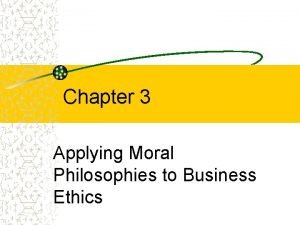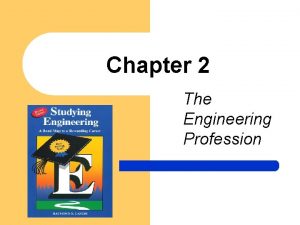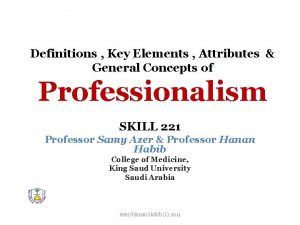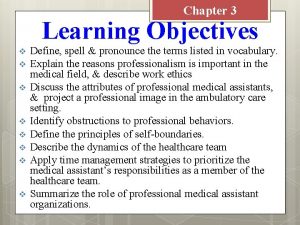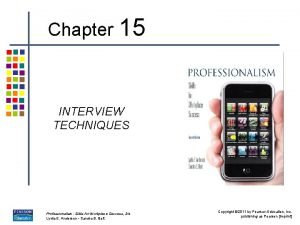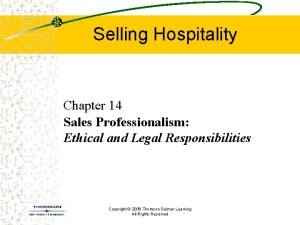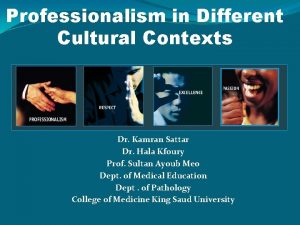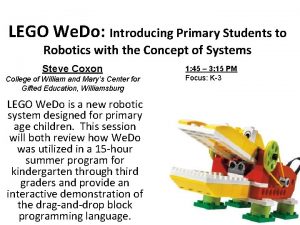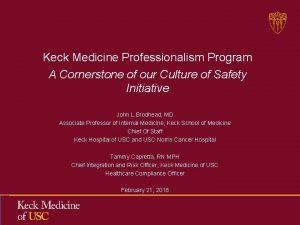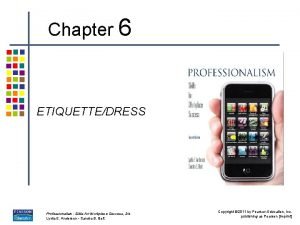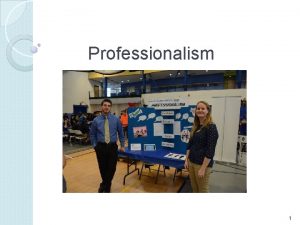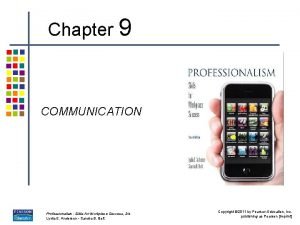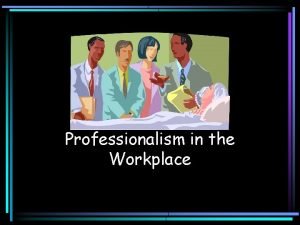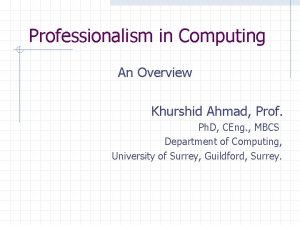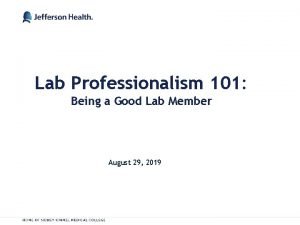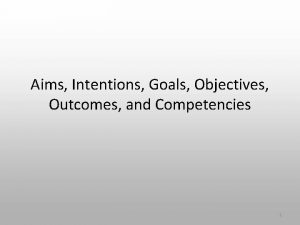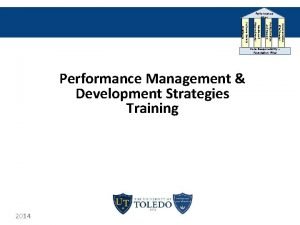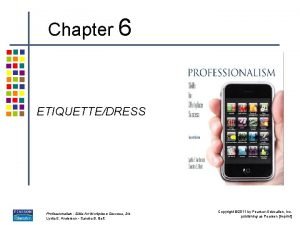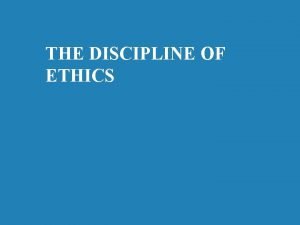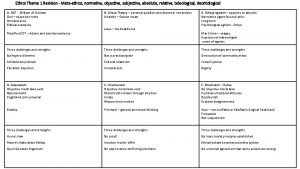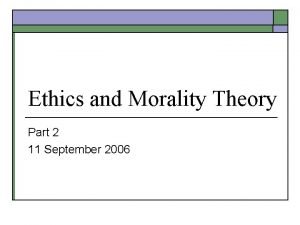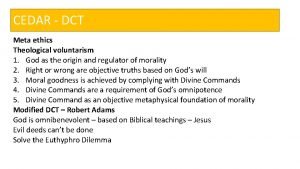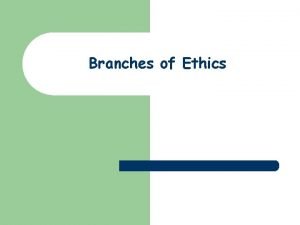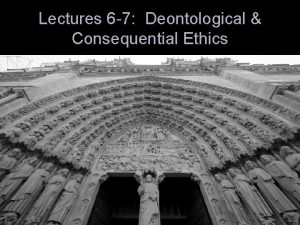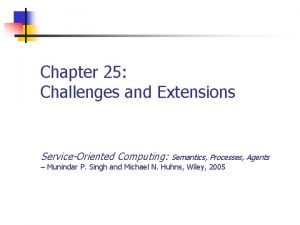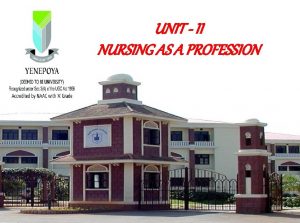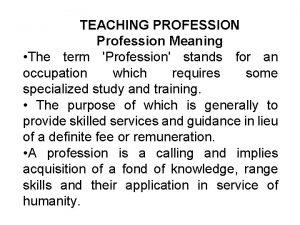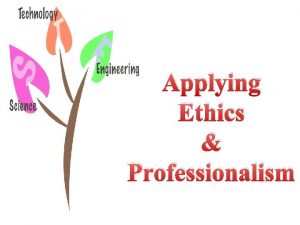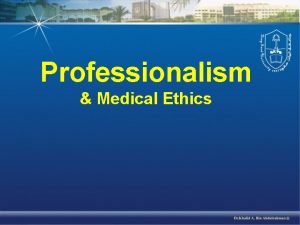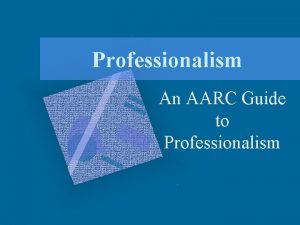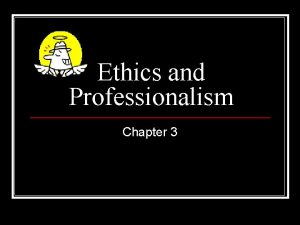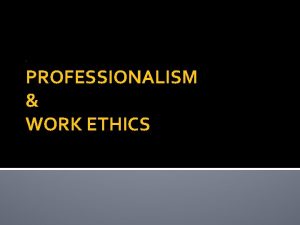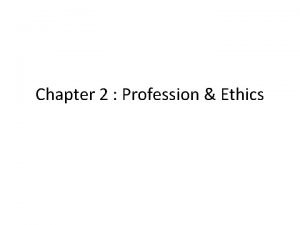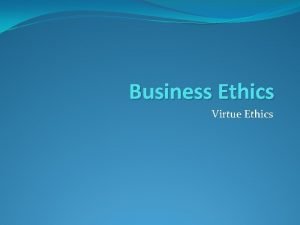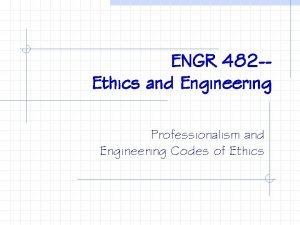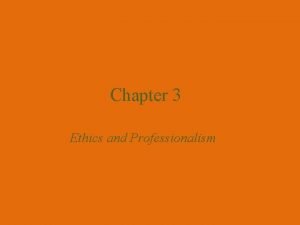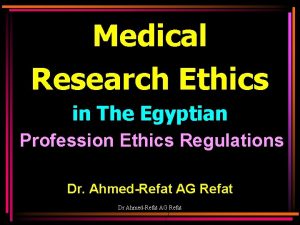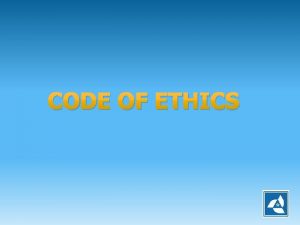Applying Ethics Professionalism Engineering as a Profession Engineering






















































- Slides: 54

Applying Ethics & Professionalism

Engineering as a Profession: Engineering training deals with the exact sciences. That sort of exactness makes for truth and conscience. C: Sense of right and Wrong It might be good for the world if more men had that sort of mental start in life even if they did not pursue the profession.

It is a great profession. There is the fascination of watching a figment of the imagination emerge through the aid of science to a plan on paper. Then it moves to realization in stone or metal or energy. Then it brings jobs and homes to men/woman Then it elevates the standards of living and adds to the comforts of life That is the engineer's high privilege

The great liability of the engineer compared to men of other professions is that his works are out in the open where all can see them. His acts, step by step, are in hard substance. He cannot bury his mistakes in the grave like the doctors. He cannot, like the architects, cover his failures with trees and vines. He cannot, like the politicians, screen his shortcomings by blaming his opponents and hope that the people will forget.

On the other hand, • unlike the doctor, his is not a life among the weak. • Unlike the soldier, destruction is not his purpose. • Unlike the lawyer, quarrels are not his daily bread. • No doubt as years go by people forget which engineer did it, even if they ever knew. Or some politician puts his name on it. Or they credit it to some promoter who used other people's money with which to finance it.

• But the engineer himself looks back at the unending stream of goodness which flows from his successes with satisfactions that few professions may know. And the verdict of his fellow professionals is all the accolade he wants.


The engineer performs many public functions from which he gets only philosophical satisfactions. Most people do not know it, but he is an economic and social force. Every time he discovers a new application of science, thereby creating a new industry, providing new jobs, adding to the standards of living, he also disturbs everything that is. He is also the person who really corrects monopolies and redistributes national wealth. Columbus discovery of America

What is a Professional Engineer? Professional engineering is: 1. Any act of planning, planning designing, designing composing, composing evaluating, evaluating advising, advising reporting, reporting directing or supervising (or the managing of any such act); 2. That requires the application of engineering principles; principles and 3. Concerns the Safeguarding of life, life health, health property, property economic interests, interests the public welfare or the environment

Great Reasons to Study Engineering: Reason 1: Money Reason 2: Prestige Reason 3: Professionalism Reason 4: Flexibility and Choice Reason 5: Intellectual Development Reason 6: Entrepreneurship Reason 7: Challenge Reason 8: Creativity Reason 9: Discovery Reason 10: Society Needs You

Money This is always one of the top reasons to study anything. It's important to know that engineers are among the top-paid professions world-wide It's well known that if you want money, engineering is one of the best ways to go. And since money is so important in our world, especially in these economic times, this is one factor you should be considering carefully.

Occupation Employer Salary CEO of Microsoft $18. 3 million (with per annum stock grant and bonus)

Prestige Along with doctors and lawyers, engineers are professionals who have a lot of prestige. Wouldn't your mother be proud to tell all her relatives and friends that her son or daughter is an engineer? You'll gain a desired job image, and join a profession that supports national and global competitiveness, security, and rising living standards. Being an engineer just makes you look great!

Professionalism Engineering programs worldwide are among the top, most-advanced educational programs. Study with top-of-the-line technology, receive great coop placements and training, and join a profession like no other. While working, you'll benefit from not only competitive wages and prestige- being a member of an engineering society will give you access to information and technology that will help you do your work better and enjoy life. Engineering is a professional choice.

Flexibility and Choice These days, everybody's looking for choice. Engineering offers so many choices you can have a hard time deciding on which one fits you- from electrical and mechanical to computer science or civil, the various areas of engineering are all exciting and in high demand. Engineering is a great choice that opens up many paths for the future.

Intellectual Development Engineering will help you grow and develop your ways of thinking Becoming an engineer will force you to work on many transferable skills including problem-solving and critical reasoning. In addition you'll study a large variety of topics in school, including engineering courses but also sciences, and even some arts and languages. Knowing more and having more useful skills will develop you as a person.

Entrepreneurship Nobody wants to be a little bolt in a big corporate machine. Studying engineering provides you with the knowledge and skills to open up your own business and become your own boss.

• Engineering training exposes you to businesses and gets you more familiar with things like finance and marketing, which is important for business purposes, and transferable skills will help you run your own company. • Having technical knowledge will allow you to make a product and centre a business around it (just like John Phillip Green and Malgosia Green who studied computer science and systems design engineering and founded Learn. Hub!)

Challenge Everyone likes a good challenge, since life would be boring otherwise. Engineering is a challenge. Throughout both your studies and your later career, you will be faced with problems which will require your creativity and logical analysis skills. Real world problems will be open ended with no wrong or right answer- it'll be up to you to find a solution and stand up to it, convincing others it's right.

Creativity Most jobs don't allow you to be creative. Engineering, on the other hand, lets you exercise your judgment however you want. You'll need to be creative to come up with solutions to fascinating problems, and you'll be able to use both concrete knowledge and your own thoughts and views when coming up with a successful original design or development. Engineering is the art of science!

Discovery An engineering education will help you discover how the world works. You may be dealing with recent issues such as electric cars, alternative energy sources, nuclear reactors, and more. You may end up seeking for answers on how to solve world hunger or what kinds of technology cause cancer. Engineering is interconnected with science and research, and it will allow you to learn and discover a world of knowledge.

Society Needs You If you're smart, you have a responsibility to society. Don't waste your brain power- become an engineer. From the early days of dawn engineers have worked to benefit society- developing everything from necessary forms of safety and security measures and transportation mechanisms, to devices and technologies that enrich life and make it better and more comfortable for everyone. New engineering trends may help solve issues like diseases, hunger, energy, and pollution problems. Make a differencehelp us engineer a better tomorrow.

Types of Natural Resources

Renewable resources are natural resources that can be replenished in a short period of time.

A renewable resource is an organic natural resource that can replenish in due time compared to the usage, either through biological reproduction or other naturally recurring processes. Renewable resources are a part of Earth's natural environment and the largest components of its ecosphere. A positive life cycle assessment is a key indicator of a resource's sustainability Paul Alfred Weiss defined Renewable Resources as: "The total range of living organisms providing man with food, fibres, drugs, etc. . . ".

Food and water: Water resources Water can be considered a renewable material when carefully controlled usage, treatment, and release are followed. For example, groundwater is usually removed from an aquifer at a rate much greater than its very slow natural recharge, and so groundwater is considered non-renewable. Removal of water from the pore spaces may cause permanent compaction (subsidence) that cannot be renewed. 97. 5% of the water on the Earth is salt water, and 3% is fresh water; slightly over two thirds of this is frozen in glaciers and polar ice caps. The remaining unfrozen freshwater is found mainly as groundwater, with only a small fraction (0, 008%) present above ground or in the air.


• Water pollution is one of the main concerns regarding water resources. • It is estimated that 22% of worldwide water is used in industry. • Major industrial users include hydroelectric dams, thermoelectric power plants, which use water for cooling, ore and oil refineries, which use water in chemical processes, and manufacturing plants, which use water as a solvent.

Non agricultural food: Food is any substance consumed to provide nutritional support for the body. Most food has its origin in renewable resources. Food is obtained directly from plants and animals. Wild berries and other fruits, mushrooms, plants, seeds and naturally growing edible resources, still represent a valuable source of nutrition in many countries, especially in rural areas. in fact many wild animals are dependent on wild plants and fruits as a source of food. Hunting may not be the first source of meat in the modernized world, but it is still an important and essential source for many rural and remote groups. It is also the sole source of feeding for wild carnivores.

Sustainable agriculture: It is defined as "an integrated system of plant and animal production practices having a site-specific application that will last over Expansion of agricultural land has an impact on biodiversity and contributes to deforestation. The Food and Agriculture Organisation of the United Nations estimates that in coming decades, cropland will continue to be lost to industrial and urban development, along with reclamation of wetlands, and conversion of forest to cultivation, resulting in the loss of biodiversity and increased soil erosion.

Threats to renewable resources: • Renewable resources are endangered by nonregulated industrial developments and growth. They must be carefully managed to avoid exceeding the natural world's capacity to replenish them. A life cycle assessment provides a systematic means of evaluating renewability.

This is a matter of sustainability in the natural environment. • Overfishing • Deforestation • Endangered species

• Some renewable resources, species and organisms are facing a very high risk of extinction caused by growing human population and over-consumption. • It has been estimated that over 40% of all living species on Earth are at risk of going extinct. • Many nations have laws to protect hunted species and to restrict the practice of hunting. • Other conservation methods includes restricting land development or creating preserves.

Non-Renewable Resources A non renewable resource is a natural resource that cannot be re-made or re-grown at a scale comparable to its consumption. Examples of Non-Renewable Resources: Ø Coal. Ø Petroleum. Ø Natural gas.

Coal: coal is used as a fuel, it takes millions of years to regenerate it, so once we dig it all up, and, burn it, then it's finished. It doesn't renew itself every day. If somehow, a community uses, coal at a large scale comparable to its consumption. It will run out, and will have to wait for a long time, so that it will regenerate for use, which is practically impossible, so it is considered as non-renewable resource.

Petroleum: This type of resources are resources for which there is a limited supply. So, The supply of petroleum comes from the Earth itself and, as it typically takes millions of years to develop and is finite. Natural gas: Natural gas is the result of decomposing plants and animals that were trapped beneath rock millions of years ago. So once its used it takes a millions of time to regenerate, so it is a non-renewable resource.

Economic models: In economics, a non-renewable resource is defined as goods, where greater consumption today implies less consumption tomorrow. David Ricardo in his early works analyzed the pricing of exhaustible resources, where he argued that the price of a mineral resource should increase over time. He argued that the spot price is always determined by the mine with the highest cost of extraction, and mine owners with lower extraction costs benefit from a differential rent.

• However, nearly all metal prices have been declining over time in inflation adjusted terms, because of a number of false assumptions in the above. • Firstly, metal resources are non-renewable, but on a world scale, largely inexhaustible. • This is because they are present throughout the earth's crust on a vast scale, far exceeding human demand on all time scales. • Metal ores however, are only extracted in those areas where nature has concentrated the metal in the crust to a level whereby it is locally economic to extract. • This also depends on the available technology for both finding the metal ores as well as extracting them, which is constantly changing. • If the technology or demand changes, vast amounts of metal previously ignored can become economically extractable.

Sustainable development: Sustainable development is a road-map, an action plan, for achieving sustainability in any activity that uses resources and where immediate and intergenerational replication is demanded. As such, sustainable development is the organizing principle for sustaining finite resources necessary to provide for the needs of future generations of life on the planet. It is a process that envisions a desirable future state for human societies in which living conditions and resource-use continue to meet human needs without undermining the "integrity, stability and beauty" of natural biotic systems.


Sustainability and Sustainable Development: As a working definition, sustainability can be defined as the practice of maintaining processes of productivity indefinitely—natural or human made— by replacing resources used with resources of equal or greater value without degrading or endangering natural biotic systems. According to M. Hasna, sustainability is a function of social, economic, technological and ecological themes. Sustainable development ties together concern for the carrying capacity of natural systems with the social, political, and economic challenges faced by humanity.

A diagram indicating the relationship between the "three pillars of sustainability", in which both economy and society are constrained by environmental limits

• The term sustainable development rose to significance after it was used by the Brundtland Commission in its 1987 report Our Common Future. • In the report, the commission coined what has become the most often-quoted definition of sustainable development: "development that meets the needs of the present without compromising the ability of future generations to meet their own needs”. • The United Nations Millennium Declaration identified principles and treaties on sustainable development, including economic development, social development and environmental protection.

Domains of Sustainability : There are four Domains 1. Ecology 2. Economics 3. Politics and 4. Culture


Ecology Focusing on the important dimension of human engagement with and within nature, but also including the built-environment. 1. Materials and energy 2. Water and air 3. Habitat and settlements 4. Built-form and transport 5. Embodiment and sustenance 6. Emission and waste

Economics Associated with the production, use, and management of resources, where the concept of ‘resources’ is used in the broadest sense of that word. 1. Production and resourcing 2. Exchange and transfer 3. Accounting and regulation 4. Consumption and use 5. Labor and welfare 6. Technology and infrastructure 7. Wealth and distribution

Politics The political is defined as the practices and meanings associated with basic issues of social power, such as organization, authorization, legitimating and regulation. The parameters of this area extend beyond the conventional sense of politics to include not only issues of public and private governance but more broadly social relations in general. 1. Organization and governance 2. Law and justice 3. Communication and critique 4. Representation and negotiation 5. Security and accord 6. Dialogue and reconciliation 7. Ethics and accountability

Culture The cultural domain is defined as the practices, discourses, and material expressions, which, over time, express continuities and discontinuities of social meaning. 1. Identity and engagement 2. Creativity and recreation 3. Memory and projection 4. Belief and ideas 5. Gender and generations 6. Enquiry and learning 7. Wellbeing and health

Technology transfer: • The Ethiopian government has decided to encourage technology transfer activities at different stages of educational and training institutions, to contribute to the boosting economy in the near future. • Presently, the term Industry Extension Service is one of the terms mostly associated to the TVET (Technical and Vocational Education and Training), where the TVET institutions are expected to help the local small industries, in filling their skill gaps, giving training in entrepreneurial skills, technology transfer and improvement productivity.

• Technology is defined differently by different actors. For this purpose only in Ethiopia, it is defined as the process whereby different inputs are converted into marketable output. • Technology transfer is one of the core issues of industry extension service where technology can be identified in terms of • Techno ware, • Info ware, • Human ware or • Orga ware.

Techno ware: includes materials, gadgets, etc. Human ware: includes the human knowledge, ability, experience, etc. Info ware: includes organized information, work processes, design and blueprints, etc. Orga ware: includes the organizational structures, setups, methods of doing things, etc.

Joint ventures of technology transfer: Technology transfer through international joint ventures is considered important to enhance competitiveness, exploit opportunities and boost economic growth. A common observation is, however, that such ventures often fail. Present insights regarding transfer processes, influencing factors, and relationships between technology transfer and venture success — if any — are modest.

Thank You
 Issues and ethics in the helping profession
Issues and ethics in the helping profession Applying moral philosophies to business ethics
Applying moral philosophies to business ethics Define engineering profession
Define engineering profession Engineering as a profession
Engineering as a profession No professionalism
No professionalism Domain 4 examples
Domain 4 examples Professionalism and integrity
Professionalism and integrity Professionalism workshop
Professionalism workshop Professionalism definition
Professionalism definition Having a courteous conscientious and respectful approach
Having a courteous conscientious and respectful approach Professionalism skills for workplace success
Professionalism skills for workplace success Attributes of professionalism
Attributes of professionalism What is professionalism
What is professionalism Sales professionalism
Sales professionalism What is professionalism
What is professionalism Project management professionalism
Project management professionalism Professionalism conclusion
Professionalism conclusion Professionalism conclusion
Professionalism conclusion Gracious professionalism examples
Gracious professionalism examples Vanderbilt professionalism program
Vanderbilt professionalism program Ac 61-65
Ac 61-65 Professionalism: skills for workplace success
Professionalism: skills for workplace success What are the three p's of professionalism
What are the three p's of professionalism Professionalism objectives
Professionalism objectives Professionalism skills for workplace success
Professionalism skills for workplace success Professionalism is judged against a set of
Professionalism is judged against a set of Professionalism in computing
Professionalism in computing Labarchives jefferson
Labarchives jefferson Integrity and professionalism
Integrity and professionalism Professionalism in a sentence
Professionalism in a sentence Professional development for teachers
Professional development for teachers What is professionalism
What is professionalism What is professionalism
What is professionalism Four pillars of service excellence
Four pillars of service excellence Gracious professionalism definition
Gracious professionalism definition Professionalism
Professionalism Professionalism skills for workplace success
Professionalism skills for workplace success Descriptive ethics
Descriptive ethics Normative ethics
Normative ethics Macro ethics meaning
Macro ethics meaning Factual inquiry in ethics
Factual inquiry in ethics Meta ethics vs normative ethics
Meta ethics vs normative ethics Descriptive ethics vs normative ethics
Descriptive ethics vs normative ethics Descriptive ethics vs normative ethics
Descriptive ethics vs normative ethics Meta ethics vs normative ethics
Meta ethics vs normative ethics L
L Virtue ethics vs utilitarianism
Virtue ethics vs utilitarianism Teleological ethics vs deontological ethics
Teleological ethics vs deontological ethics What profession would you like to have?
What profession would you like to have? Definition of nursing as a profession
Definition of nursing as a profession Profession of faith (shahada)
Profession of faith (shahada) What is occupation
What is occupation The cpa profession chapter 2
The cpa profession chapter 2 The cpa profession chapter 2
The cpa profession chapter 2 Teaching profession meaning
Teaching profession meaning

